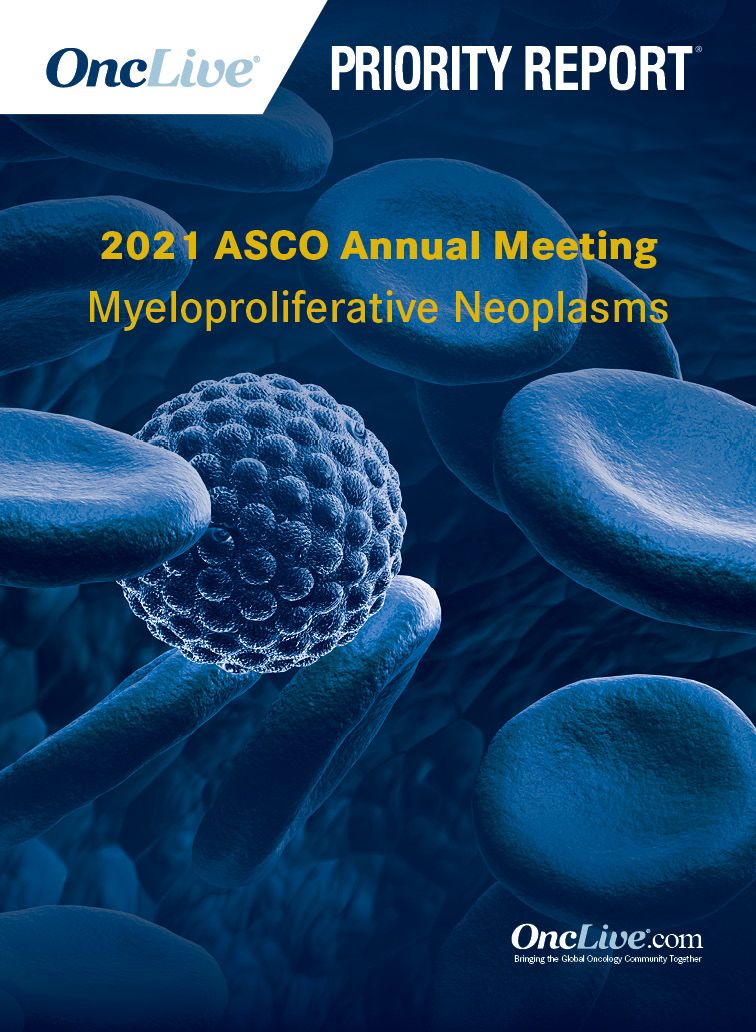Publication
Article
Supplements and Featured Publications
Week 24 Transfusion Independence With Momelotinib Is Associated With Improved OS in Myelofibrosis
Author(s):
Week 24 transfusion independence was associated with an improvement in overall survival vs week 24 transfusion dependence in patients with myelofibrosis who were randomized to momelotinib in the phase 3 SIMPLIFY 1 and SIMPLIFY 2 trials.
Ruben A. Mesa, MD

Week 24 transfusion independence was associated with an improvement in overall survival (OS) vs week 24 transfusion dependence in patients with myelofibrosis who were randomized to momelotinib in the phase 3 SIMPLIFY 1 (NCT01969838) and SIMPLIFY 2 (NCT02101268) trials, according to subgroup analyses from both trials that were presented during the 2021 ASCO Annual Meeting.
In SIMPLIFY 1, week 24 transfusion independent responders randomized to momelotinib had an OS advantage, with a median OS that was not reached and a 3-year OS rate of 80% (HR, 0.30; P <.0001) vs a median OS of 3 years and a 3-year OS rate of 50% in momelotinib transfusion independent non-responders.
In SIMPLIFY 2, week 24 transfusion independent responders randomized to momelotinib showed a trend toward improved OS vs momelotinib transfusion independent non-responders (HR, 0.57; P = .0652).
The comparison between OS from week 24 and OS from randomization demonstrated comparable results.
“In both SIMPLIFY studies, momelotinib transfusion independence in responders showed an advantage in OS,” lead study author Ruben A. Mesa, MD, director of the Mays Cancer Center at UT Health San Antonio MD Anderson Cancer Center, said in a virtual presentation of the data. “These findings suggest that clinical benefit of transfusion independence may predict for improved OS in myelofibrosis, supporting the clinical relevance of momelotinib’s proerythropoietic inhibition of ACVR1.”
Approximately 60% of patients with myelofibrosis are anemic and 45% require red blood cell transfusions within 1 year of diagnosis, with the majority progressing to transfusion dependency.
Transfusion dependence and anemia are negative prognostic factors in myelofibrosis and confer poor quality of life.
Approved JAK inhibitors provide spleen and symptom improvements but are typically myelosuppressive and do not treat transfusion dependence.
Momelotinib is a potent JAK1/2 and ACVR1/ALK2 inhibitor that is effective against anemia, constitutional symptoms, and splenomegaly in myelofibrosis. Additionally, preclinical and clinical studies support the use of momelotinib as an effective agent against anemia and transfusion dependence through inhibition of ACVR1/ALK2.
Prior data demonstrated that rates of week 24 transfusion independence were higher in the momelotinib arms of SIMPLIFY 1 and SIMPLIFY 2, which compared momelotinib with ruxolitinib (Jakafi) in JAK inhibitor–naïve patients and momelotinib with best available therapy in ruxolitinib pretreated patients, respectively.
Moreover, momelotinib has been shown to provide higher rates of transfusion independence vs ruxolitinib irrespective of the degree of baseline anemia, baseline platelet count, or transfusion status.
To evaluate the relationship between efficacy outcomes and OS, subgroup analyses were performed for patients randomized to momelotinib in SIMPLIFY 1 and SIMPLIFY 2. The subgroups were defined as follows:
- Week 24 transfusion independence response: No red blood cell transfusion for at least 12 weeks, with a hemoglobin level of at least 8 g/dL
- Week 24 spleen response: At least a 35% reduction in spleen volume vs baseline
- Week 24 symptom response: At least a 50% reduction in Myelofibrosis Symptom Assessment Form total symptom score vs baseline
Additional analyses of patients with spleen and symptom response at week 24 in SIMPLIFY 1 indicated that the hazard ratios for spleen and symptoms among responders vs non-responders were 0.59 (P = .0904) and 0.66 (P = .1657), respectively. Although these findings were not statistically significant, they suggest a trend toward improved OS in responders for spleen and symptom response.
Similarly, in SIMPLIFY 2, no statistically significant difference in OS was observed between spleen and symptom responders vs non-responders, with hazard ratios of 2.06 (P = .1004) and 0.67 (P = .2513), respectively.
“The new subgroup analysis of OS in patients with myelofibrosis randomized to momelotinib suggest patients who are transfusion independent at week 24 have clinically relevant improvement in OS,” concluded Mesa.
Reference
- Mesa RA, Oh ST, Gerds AT, et al. Association of transfusion independence with improved overall survival in myelofibrosis patients receiving momelotinib. J Clin Oncol. 2021;39(suppl 15):7046. doi:10.1200/JCO.2021.39.15_suppl.7046










